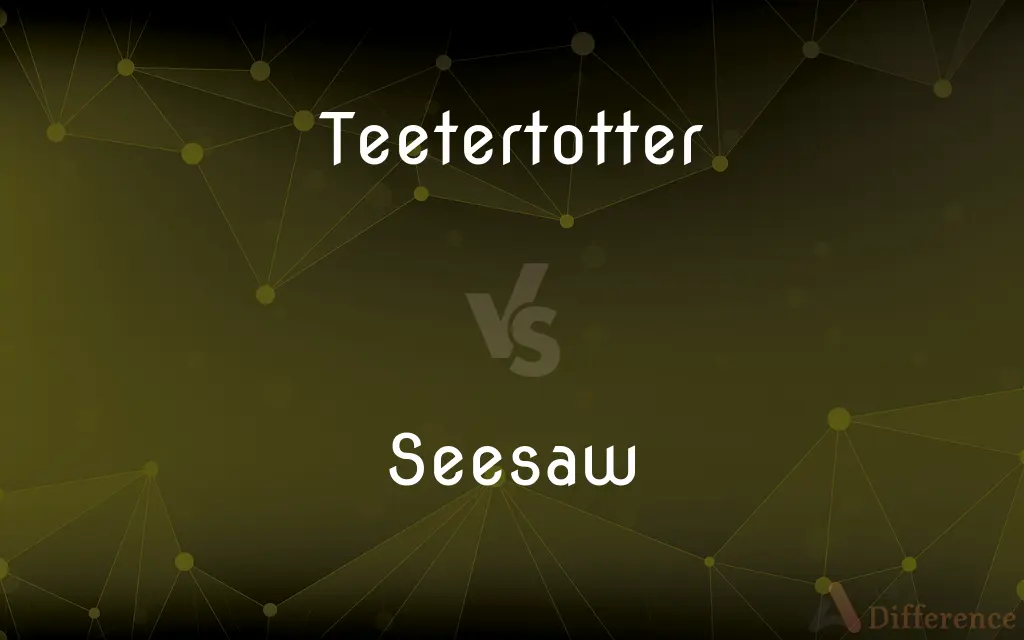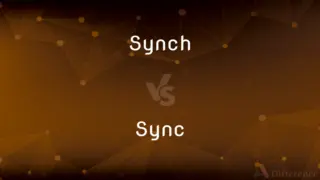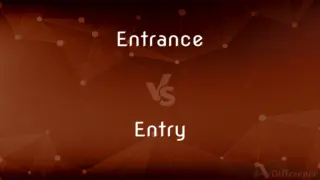Teetertotter vs. Seesaw — What's the Difference?
By Tayyaba Rehman & Urooj Arif — Updated on April 8, 2024
"Teetertotter" and "seesaw" refer to the same playground equipment, with "teetertotter" used more in North American English, while "seesaw" is preferred in British English and globally.

Difference Between Teetertotter and Seesaw
Table of Contents
ADVERTISEMENT
Key Differences
Teetertotter, commonly used in North American English, denotes a long, narrow board balanced in the middle so that, as one end goes up, the other goes down. On the other hand, seesaw, the term more commonly used outside of North America, refers to the same piece of playground equipment, emphasizing the up-and-down motion it enables for two users at opposite ends.
The term "teetertotter" conveys a playful, somewhat onomatopoeic sense that mimics the motion of the equipment it describes. It's often associated with the playful language and sounds of children's games. Seesaw, whereas, might not be as onomatopoeic as "teetertotter," but it effectively captures the reciprocal action of the play equipment, where the balance and weight of one side directly impact the other.
In terms of cultural references and usage, "teetertotter" is deeply ingrained in North American childhood experiences, often appearing in children's books, songs, and educational materials specific to that region. Seesaw, on the other hand, is recognized worldwide, not only in playgrounds but also in literature and discussions about play, making it a more universally understood term.
While "teetertotter" may evoke a sense of nostalgia or regional identity among those familiar with North American English, "seesaw" benefits from global recognition, ensuring clarity and understanding across different English-speaking cultures. This distinction highlights how variations in language can reflect and preserve cultural identities.
Both terms, despite their regional differences, highlight the universal appeal of simple, interactive play. Whether called a teetertotter or a seesaw, this equipment symbolizes balance, coordination, and the joy of shared experiences, underlining the commonality of play across cultures.
ADVERTISEMENT
Comparison Chart
Regional Usage
Predominantly North American English
Preferred in British English and globally
Onomatopoeic Quality
Highly onomatopoeic, mimicking the equipment's motion
Less onomatopoeic, focuses on the action of seeing and sawing
Cultural References
Common in North American children's literature
Widely recognized in global literature and discussions about play
Sense of Identity
Evokes regional identity and nostalgia
Promotes global understanding and connectivity
Symbolism
Highlights playful language and childhood games
Symbolizes balance, coordination, and shared experiences
Compare with Definitions
Teetertotter
A playground equipment for reciprocal play.
The children laughed while playing on the teetertotter.
Seesaw
Global term for a balancing playground equipment.
Kids from all over the world enjoy playing on a seesaw.
Teetertotter
Symbol of balance and coordination.
Life is like a teetertotter, constantly seeking balance.
Seesaw
Symbolic of ups and downs.
His moods are like a seesaw, constantly changing.
Teetertotter
Used in expressions of fluctuation.
The stock market has been teetertottering this month.
Seesaw
Used in discussions of equilibrium.
Finding a work-life balance is like being on a seesaw.
Teetertotter
Playful, onomatopoeic term.
The word 'teetertotter' sounds just like the motion it represents.
Seesaw
Represents reciprocal action.
Their debate went back and forth like a seesaw.
Teetertotter
Reflective of North American childhood.
Teetertotters remind me of my school days in Canada.
Seesaw
Universally understood playground term.
No matter where you go, a seesaw is a source of joy for children.
Seesaw
A seesaw (also known as a teeter-totter or teeterboard) is a long, narrow board supported by a single pivot point, most commonly located at the midpoint between both ends; as one end goes up, the other goes down. These are most commonly found at parks and school playgrounds.
Seesaw
A long plank balanced on a central fulcrum so that with a person riding on each end, one end goes up as the other goes down. Also called regionally dandle, dandle board, teedle board, teeter, teeterboard, teeter-totter, tilt1, tilting board.
Seesaw
The act or game of riding a seesaw.
Seesaw
A back-and-forth or up-and-down movement.
Seesaw
An action or process in which something repeatedly changes from one condition or situation to another
The seesaw in temperatures.
Seesaw
To play on a seesaw.
Seesaw
To move back and forth or up and down.
Seesaw
To change back and forth from one condition or situation to another
The lead seesawed for much of the tennis match.
Seesaw
A structure composed of a plank, balanced in the middle, used as a game in which one person goes up as the other goes down.
Seesaw
A series of up-and-down movements.
Seesaw
A series of alternating movements or feelings.
Seesaw
An abnormal breathing pattern caused by airway obstruction, characterized by paradoxical chest and abdominal movement.
Seesaw
(intransitive) To use a seesaw.
Seesaw
To fluctuate.
Seesaw
(transitive) To cause to move backward and forward in seesaw fashion.
Seesaw
Fluctuating.
Seesaw
A play among children in which they are seated upon the opposite ends of a plank which is balanced in the middle, and move alternately up and down.
Seesaw
A plank or board adjusted for this play.
Seesaw
A vibratory or reciprocating motion.
He has been arguing in a circle; there is thus a seesaw between the hypothesis and fact.
Seesaw
Same as Crossruff.
Seesaw
To move with a reciprocating motion; to move backward and forward, or upward and downward.
Seesaw
To cause to move backward and forward in seesaw fashion.
He seesaws himself to and fro.
Seesaw
Moving up and down, or to and fro; having a reciprocating motion.
Seesaw
A plaything consisting of a board balanced on a fulcrum; the board is ridden up and down by children at either end
Seesaw
Ride on a plank
Seesaw
Move up and down as if on a seesaw
Seesaw
Move unsteadily, with a rocking motion
Common Curiosities
Is there a difference between a teetertotter and a seesaw?
While they refer to the same piece of equipment, "teetertotter" is more common in North American English, and "seesaw" is used more globally.
How does a seesaw work?
A seesaw works on the principle of balance, with each side of the board moving up and down in response to the other's weight and force.
What lessons can children learn from playing on a seesaw?
Children can learn about balance, coordination, and the importance of cooperation and timing when playing on a seesaw.
Can teetertotter and seesaw be used interchangeably?
Yes, both terms can be used interchangeably to refer to the same playground equipment, though the choice of term may depend on regional preferences.
What is a teetertotter?
A teetertotter is playground equipment that allows two users to sit at opposite ends and rock back and forth.
Why is it called a teetertotter?
The term "teetertotter" mimics the sound and motion of the equipment, reflecting the playful nature of its use.
Which term is more widely used, teetertotter or seesaw?
"Seesaw" is more widely recognized and used globally, outside of North America.
Is the teetertotter a modern invention?
The concept of the teetertotter has been around for centuries, though its design and safety features have evolved over time.
Why do children enjoy playing on teetertotters/seesaws?
Children enjoy the reciprocal play, balance, and the sense of flying or floating that teetertotters and seesaws provide.
Are teetertotters safe for all ages?
While teetertotters are designed with safety in mind, supervision is recommended, especially for younger children, to ensure safe use.
Share Your Discovery

Previous Comparison
Synch vs. Sync
Next Comparison
Entrance vs. EntryAuthor Spotlight
Written by
Tayyaba RehmanTayyaba Rehman is a distinguished writer, currently serving as a primary contributor to askdifference.com. As a researcher in semantics and etymology, Tayyaba's passion for the complexity of languages and their distinctions has found a perfect home on the platform. Tayyaba delves into the intricacies of language, distinguishing between commonly confused words and phrases, thereby providing clarity for readers worldwide.
Co-written by
Urooj ArifUrooj is a skilled content writer at Ask Difference, known for her exceptional ability to simplify complex topics into engaging and informative content. With a passion for research and a flair for clear, concise writing, she consistently delivers articles that resonate with our diverse audience.














































